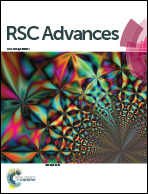Deactivation by HCl of CeO2–MoO3/TiO2 catalyst for selective catalytic reduction of NO with NH3
Abstract
The effect of HCl on a CeO2–MoO3/TiO2 catalyst for the selective catalytic reduction of NO with NH3 was investigated with BET, XRD, NH3-TPD, H2-TPR, XPS and catalytic activity measurements. The results showed that HCl had an inhibiting effect on the activity of the CeO2–MoO3/TiO2 catalyst. The deactivation by HCl of the CeO2–MoO3/TiO2 catalyst could be attributed to pore blockage, weakened interaction among ceria, molybdenum and titania, reduction in surface acidity and degradation of redox ability. The Ce3+/Ce4+ redox cycle was damaged because unreactive Ce3+ in the form of CeCl3 lost the ability to be converted to active Ce4+ in the SCR reaction. In addition, a decrease in the amount of chemisorbed oxygen and the concentrations of surface Ce and Mo was also responsible for the deactivation by HCl of the CeO2–MoO3/TiO2 catalyst.



 Please wait while we load your content...
Please wait while we load your content...